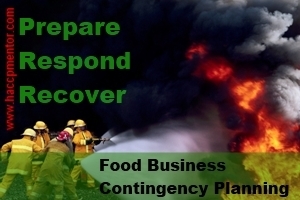All of the major food certification standards require that a food business have adequate procedures documented for the management of incidents, potential emergency situations or a crisis. A big part of this documentation relates to having contingency plans in place.
What is contingency planning?
Contingency planning is the process that prepares a food business to respond effectively to an unplanned event. It is made up of three key components – being prepared, responding to an event and post-event recovery. This post is going to review basic requirements on preparing for an incident or unplanned event.
Crisis preparation
The more a food business is prepared to handle and respond to an unplanned event, the more likely your business is to recover from the crises. To effectively prepare for an unplanned event, your food business should, at a minimum, document and implement the following:
- Nominate the Crisis Team
- Identify and assess business risks
- Develop and document plans and procedures
- Test the plan
Nominate the Crisis Team
It is essential that the crisis team has been identified. The team can be made up of any number of business representatives including management, sales and production. There are no hard and fast rules about the number of people who have to be on the team.
However, whoever is nominated, they should have the technical capability and knowledge to fulfil their responsibilities within the team. It is recommended that all team members have adequate and thorough training in crisis management and contingency planning. A clear understanding of roles and responsibilities during an unplanned event is mandatory.
Identify and assess business risks
When trying to work out what would affect your business, you can ask yourself the question “What could actually disrupt our business?”. You can further categorise these vulnerabilities into natural and made-made events.
Examples of natural events can include earthquake, tornado, cyclone, drought, flooding, bushfire, pandemics. Examples if man-made events include loss of utilities (water, gas, electricity), material shortage, product sabotage, failure of IT systems, bomb threats, accidents or industrial relation action by staff.
When you have identified all of your potential events and crises, go and estimate the probability and consequence should the event or crisis occur. You can use your own risk assessment tool or use this one.
Develop and document plans and procedures
It is imperative that your business develops plans and procedures to avoid or mitigate the risk and to respond to each of the identified risks and exposures should they occur. This development can be compared to the requirements of HACCP where you are required to control identified food safety hazards and allocate corrective actions should the hazard exceed your set critical limit.
Examples of plans and procedures include (but are not limited to):
- Evacuation plans
- Fire protection plans
- Occupational health and safety program
- Environmental policies
- Security procedures
- Insurance program
- Finance and purchasing procedures
- Building and facility closing policies
- Employee manuals
- Hazardous material plans
- Human resource planning
- Communication and media procedures
- Data storage and recovery
Test the Plan
All plans should be tested regularly to ensure suitability and effectiveness. Being prepared for any of your identified events means that all possible scenarios have been tested. You do not want to wait for a real event or crisis to find out that your contact list is out of date or plan for evacuation does not work. Conduct a mock exercise at least annually to test the crisis management plan and team.
It is also a good idea to have a procedure documented which outlines how you are going to conduct a test of your contingency plan.
Your crisis management plan should be seen as a reference tool on what to do in-case of an unplanned event or incident. It is fluid document and should not set in stone, but aim to provide some level of guidance, direction and structure. Having your plan documented will save valuable time during a crisis.




Thank you for your valuable report, I need to know the difference between emergency preparedness plan and contingencies plan, could it be in one document and procedure or It should be separated from each other.
Thank You
Hi Ahmed
Emergency preparedness and contingency plans differ slightly in that your emergency plan is about how your company will respond immediately to an issue eg. fire – get everyone out of the building. Where a contingency plan really looks at the systems and procedures that you will put in place after the immediate threat has finished. These may relate to how, for example, your business maintains continual customer supply.